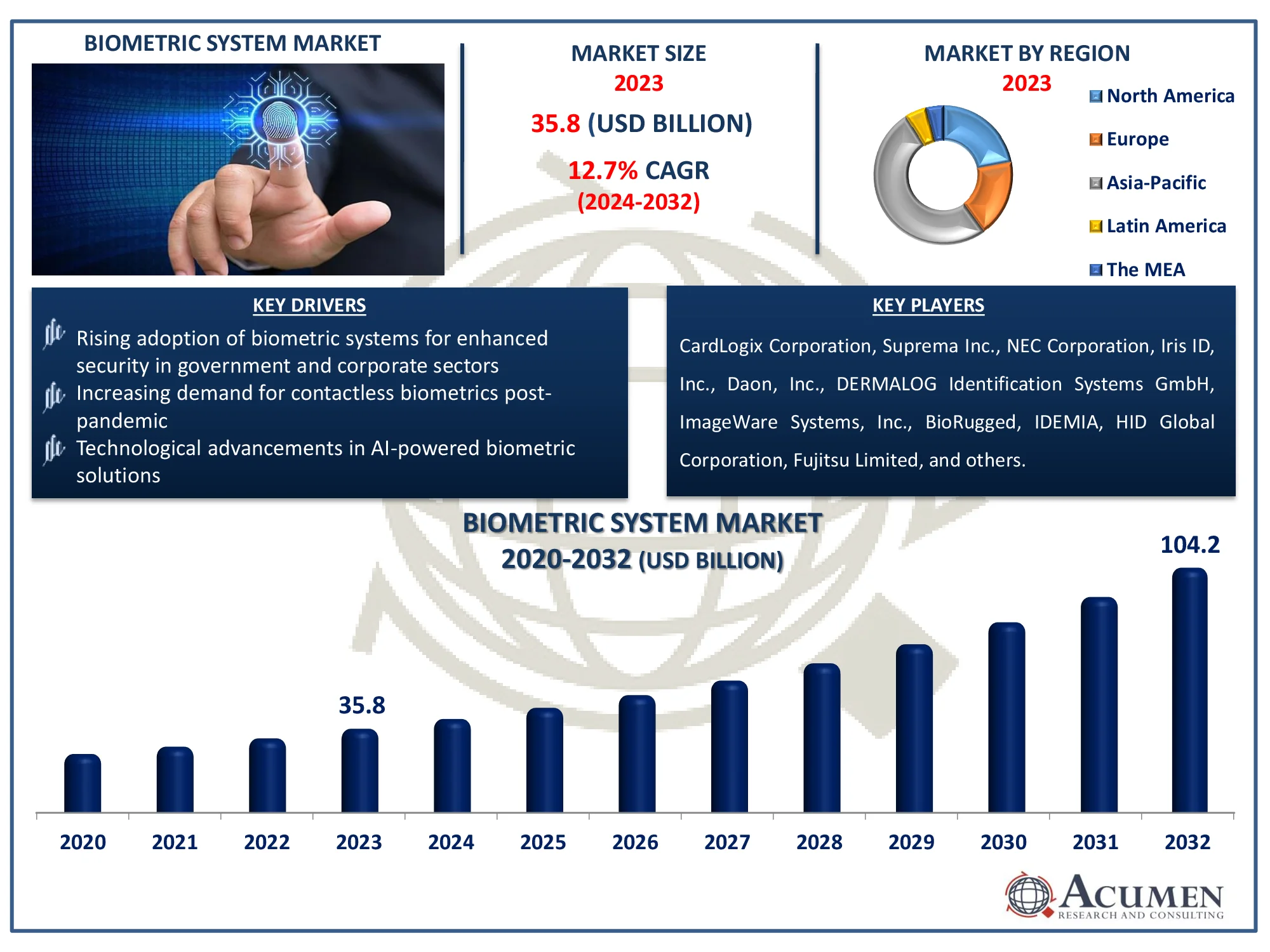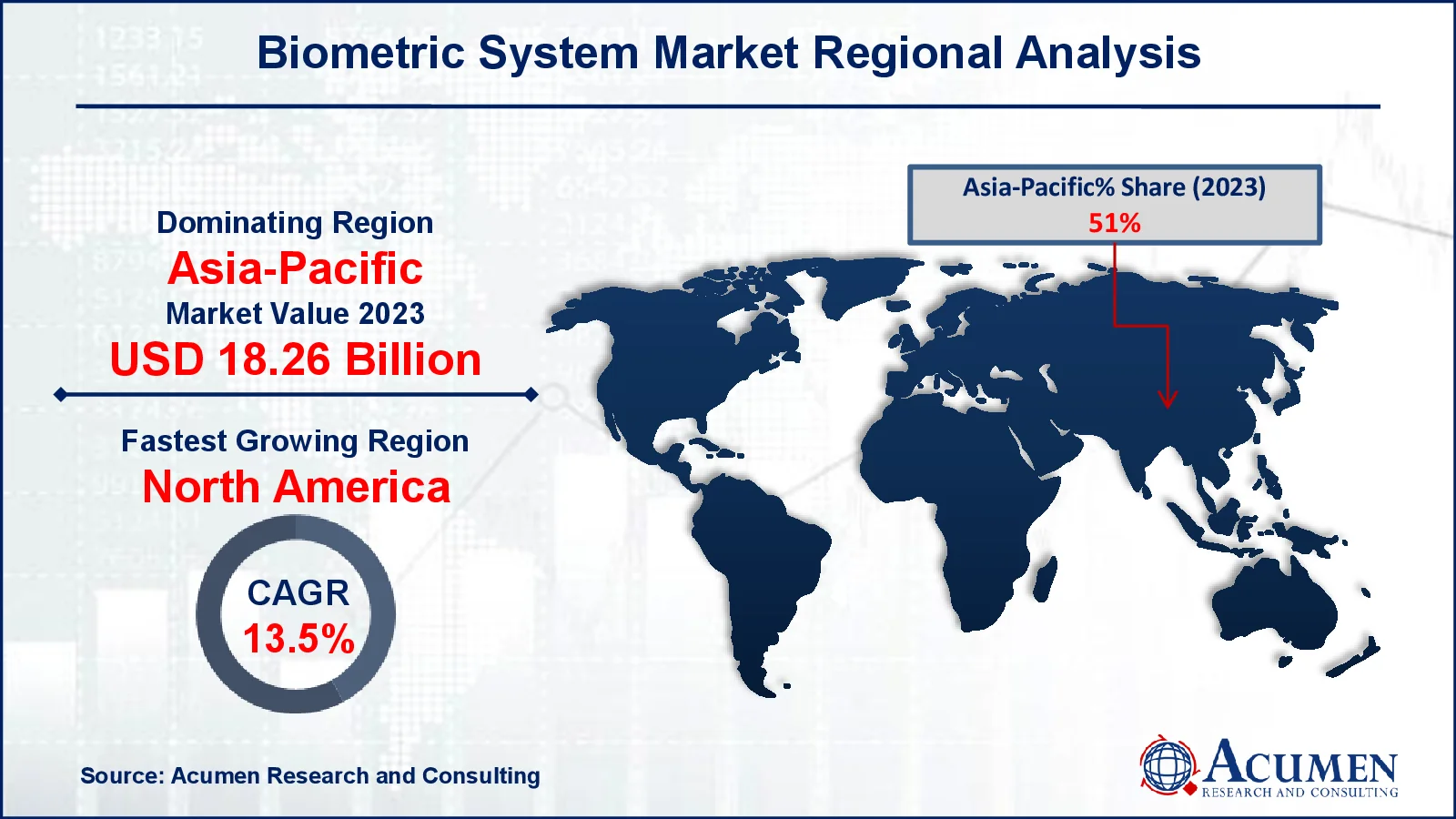Biometric System Market Size - Global Industry, Share, Analysis, Trends and Forecast 2024 - 2032
Published :
Report ID:
Pages :
Format :
Biometric System Market Size - Global Industry, Share, Analysis, Trends and Forecast 2024 - 2032
Report Coverage
- Industry Dynamics
- Market Size and Forecast Data
- Segment Analysis
- Competitive Landscape
- Regional Analysis with a Niche Focus on Country-Level Data
- High Level Analysis - Porter's, PESTEL, Value Chain, etc.
- Company Profiles of Key Players
- Option to Customize the Report As Per Your Specific Need
Request Sample Report
The Global Biometric System Market Size accounted for USD 35.8 Billion in 2023 and is estimated to achieve a market size of USD 104.2 Billion by 2032 growing at a CAGR of 12.7% from 2024 to 2032.
Biometric System Market Highlights
- The global biometric system industry is projected to reach USD 104.2 billion by 2032, growing at a CAGR of 12.7% from 2024 to 2032
- The Asia-Pacific biometric system market was valued at approximately USD 18.26 billion in 2023
- North America's biometric system market is expected to experience a CAGR of over 13.5% from 2024 to 2032
- The hardware sub-segment accounted for 61% of the market share in 2023
- The consumer electronics sub-segment represented 31% of the market share in 2023
- Integration of artificial intelligence and machine learning to improve biometric accuracy is the biometric system market trend that fuels the industry demand

A biometric system is a technology that identifies and verifies individuals based on their unique physical or behavioral characteristics, such as fingerprints, facial recognition, iris scans, or voice patterns. It is widely used for security and authentication purposes in various fields. In banking, it ensures secure access to accounts and simplifies login processes. Biometric systems are also employed in border control, healthcare, and workplace attendance systems to enhance accuracy and reduce fraud. This technology offers a convenient and reliable way to verify identity without relying on traditional methods like passwords or ID cards.
Global Biometric System Market Dynamics
Market Drivers
- Rising adoption of biometric systems for enhanced security in government and corporate sectors
- Increasing demand for contactless biometrics post-pandemic
- Technological advancements in AI-powered biometric solutions
Market Restraints
- High initial installation and maintenance costs
- Concerns over data privacy and misuse of biometric information
- Performance issues in adverse environmental conditions
Market Opportunities
- Growing application of biometrics in e-commerce and online banking
- Expanding adoption of biometric systems in emerging markets
- Integration of biometrics with IoT and smart devices for seamless user experiences
Biometric System Market Report Coverage
|
Market |
Biometric System Market |
|
Biometric System Market Size 2023 |
USD 35.8 Billion |
|
Biometric System Market Forecast 2032 |
USD 104.2 Billion |
|
Biometric System Market CAGR During 2024 - 2032 |
12.7% |
|
Biometric System Market Analysis Period |
2020 - 2032 |
|
Biometric System Market Base Year |
2023 |
|
Biometric System Market Forecast Data |
2024 - 2032 |
|
Segments Covered |
By Offering, By Mobility, By Contact Type, By Deployment, By Application, By Vertical, and By Geography |
|
Regional Scope |
North America, Europe, Asia Pacific, Latin America, and Middle East & Africa |
|
Key Companies Profiled |
CardLogix Corporation, Suprema Inc., NEC Corporation, Iris ID, Inc., Daon, Inc., DERMALOG Identification Systems GmbH, ImageWare Systems, Inc., BioRugged, IDEMIA, HID Global Corporation, Fujitsu Limited, Precise Biometrics, Aware, Inc., Cognitec Systems GmbH, Thales, BIO-key International, Integrated Biometrics, LLC, and M2SYS Technology. |
|
Report Coverage |
Market Trends, Drivers, Restraints, Competitive Analysis, Player Profiling, Covid-19 Analysis, Regulation Analysis |
Biometric System Market Insights
The global biometrics market has grown significantly in recent years, owing to technology developments and the evolution of mobile devices, which have enabled previously unattainable or imagined use cases. For example, biometrics has made it possible to register voters in low-literacy economies and identify people of interest in vast crowds. Biometrics has become an indispensable tool in a variety of businesses since it provides a seamless procedure for identifying and authenticating persons with high accuracy. Additionally, government initiatives supporting biometric adoption, the integration of biometric technology into smartphones, its rising application in healthcare and financial institutions, and its broad usage in criminal identification are all key drivers driving the growth of the biometric systems market. For instance, the National Institutes of Health estimates that a Biometric Automated Patient and Procedure Identification System (BAPPIS) was designed to eliminate patient and procedure identification mistakes caused by human interactions in radiotherapy administration and surgery. The BAPPIS system uses fingerprints to identify patients and verify treatment procedures.
The growing implementation of biometrics in e-commerce and online banking creates new opportunities for the biometric system market. According to IEEE Xplore, Aadhaar maintains a person's biometric information, such as fingerprints, which may then be used to log into internet banking, making the procedure simpler and more convenient. The biometric service is primarily intended to streamline and secure the internet banking login process. Rather than entering passwords or PINs, users can validate their identity using fingerprints or other biometric data connected to their Aadhaar. This improves ease and security by guaranteeing that only authorized individuals can access financial services.
 Biometric System Market Segmentation
Biometric System Market Segmentation
The worldwide market for biometric system is split based on offering, mobility, contact type, deployment, application, vertical, and geography.
Biometric System Market By Offering
- Hardware
- Fingerprint Sensor
- Cameras
- Readers and Scanners
- Other Biometric Hardware
- Software
According to the biometric system industry analysis, the hardware segment dominates because it provides the critical infrastructure for capturing and processing biometric data. Devices such as fingerprint scanners, facial recognition cameras, and iris scanners are essential for biometric authentication. The expanding use of these devices in industries such as banking, government, healthcare, and security has fueled their popularity. Furthermore, developments in hardware technology assure greater precision, speed, and dependability, reinforcing their industry leadership.
Biometric System Market By Mobility
- Fixed
- Portable
According to the biometric system industry analysis, the fixed segment leads because it contains stationary biometric devices such as fingerprint scanners, facial recognition terminals, and iris scanning systems installed in specified locations. These systems are commonly used in secure facilities, government offices, airports, and financial institutions to verify identities and manage access. Their prominence stems from the significant demand for sturdy, dependable, and scalable solutions in fixed environments.
Biometric System Market By Contact Type
- Contact Based
- Contact-Less
- Hybrid
According to the biometric system market analysis, the contact-based segment involves fingerprint scanning and palm recognition. These systems are valued for their reliability and cost-effectiveness, making them popular in sectors such as banking, government, and employee attendance tracking. Technological advancements in contact-based devices have improved their speed and accuracy, further driving adoption. Additionally, contact-less segment growing at rapid space in industry.
Biometric System Market By Deployment
- On-Premises
- Cloud-Based
- Integrated Deployment
According to the biometric system industry analysis, on-premises deployment its higher security, control, and customization options for businesses and institutions. Organizations often prefer on-premises systems for sensitive data handling, such as in banking, government, and healthcare, where privacy is a top concern. However, cloud-based and integrated deployments are seeing significant growth as they offer greater scalability, flexibility, and cost-efficiency, particularly for small to medium-sized enterprises. As cloud technology advances, the demand for cloud-based biometric solutions is expected to rise, especially for remote or mobile applications.
Biometric System Market By Application
- Iris Recognition
- Face Recognition
- Voice Recognition
- Fingerprint Recognition
- Vein Recognition
- Others
According to the biometric system market forecast, fingerprint recognition is predicted to expand rapidly due to its proven reliability, accuracy, and convenience of use. It is widely used for secure authentication in a variety of industries including banking, mobile devices, healthcare, and law enforcement. Fingerprint scanning technology is gaining popularity due to the growing demand for user-friendly and secure solutions, as well as its low cost. Furthermore, developments in fingerprint recognition technologies, such as increased speed and accuracy, are boosting their popularity in consumer and enterprise applications.
Biometric System Market By Vertical
- Government
- Automotive
- Retail and E-commerce
- Healthcare
- Travel and Immigration
- Military and Defense
- Consumer Electronics
- Banking and Financial Services
- Others
According to the biometric system market forecast, consumer electronics is expected to dominate due to the widespread integration of biometric authentication in devices like smartphones, laptops, and tablets. Fingerprint scanners, facial recognition, and other biometric features are increasingly used to enhance device security and user convenience. The growing demand for secure access, contactless payments, and personalized user experiences in consumer electronics fuels the adoption of biometric systems. As technology advances, more consumer electronics products are incorporating biometrics, further driving their dominance in the industry.
Biometric System Market Regional Outlook
North America
- U.S.
- Canada
Europe
- U.K.
- Germany
- France
- Spain
- Rest of Europe
Asia-Pacific
- India
- Japan
- China
- Australia
- South Korea
- Rest of Asia-Pacific
Latin America
- Brazil
- Mexico
- Rest of LATAM
The Middle East & Africa
- South Africa
- GCC Countries
- Rest of the Middle East & Africa (ME&A)
 Biometric System Market Regional Analysis
Biometric System Market Regional Analysis
For several reasons, the Asia-Pacific (APAC) region dominates in market for biometric systems. MarterCard launches a new biometric payment passkey in India in August 2024, competing with UPI. The new service will first be tested in India with a number of the country's main payment players, including payment aggregators such as Juspay, Razor pay, and PayU, as well as significant online merchants like BigBasket and leading banks such as Axis Bank. Furthermore, the biometric system market in APAC is predicted to expand fast due to increased population awareness, technical improvements, and decreasing biometric equipment costs.
The North American market is predicted to growing worldwide biometric systems market, owing to strong adoption rates in areas such as banking, security, and the government. For instance, the Department of Homeland Security estimates that biometrics are used for detecting and preventing illegal entry into the United States, granting and administering proper immigration benefits, vetting and credentialing, facilitating legitimate travel and trade, enforcing federal laws, and enabling verification for visa applications to the US. The region's technical breakthroughs, along with rigorous security laws, are driving the market for biometric solutions. The presence of big market players increases their position in the industry.
Biometric System Market Players
Some of the top biometric system companies offered in our report include CardLogix Corporation, Suprema Inc., NEC Corporation, Iris ID, Inc., Daon, Inc., DERMALOG Identification Systems GmbH, ImageWare Systems, Inc., BioRugged, IDEMIA, HID Global Corporation, Fujitsu Limited, Precise Biometrics, Aware, Inc., Cognitec Systems GmbH, Thales, BIO-key International, Integrated Biometrics, LLC, and M2SYS Technology.
Frequently Asked Questions
How big is the biometric system market?
The biometric system market size was valued at USD 35.8 Billion in 2023.
What is the CAGR of the global biometric system market from 2024 to 2032?
The CAGR of biometric system is 12.7% during the analysis period of 2024 to 2032.
Which are the key players in the biometric system market?
The key players operating in the global market are including CardLogix Corporation, Suprema Inc., NEC Corporation, Iris ID, Inc., Daon, Inc., DERMALOG Identification Systems GmbH, ImageWare Systems, Inc., BioRugged, IDEMIA, HID Global Corporation, Fujitsu Limited, Precise Biometrics, Aware, Inc., Cognitec Systems GmbH, Thales, BIO-key International, Integrated Biometrics, LLC, and M2SYS Technology.
Which region dominated the global biometric system market share?
Asia-Pacific held the dominating position in biometric system market during the analysis period of 2024 to 2032.
Which region registered fastest CAGR from 2024 to 2032?
North America region exhibited fastest growing CAGR for market of biometric system during the analysis period of 2024 to 2032.
What are the current trends and dynamics in the global biometric system industry?
The current trends and dynamics in the biometric system market include rising adoption of biometric systems for enhanced security in government and corporate sectors, increasing demand for contactless biometrics post-pandemic, and technological advancements in AI-powered biometric solutions.
Which offering held the maximum share in 2023?
The hardware held the maximum share of the biometric system industry.


